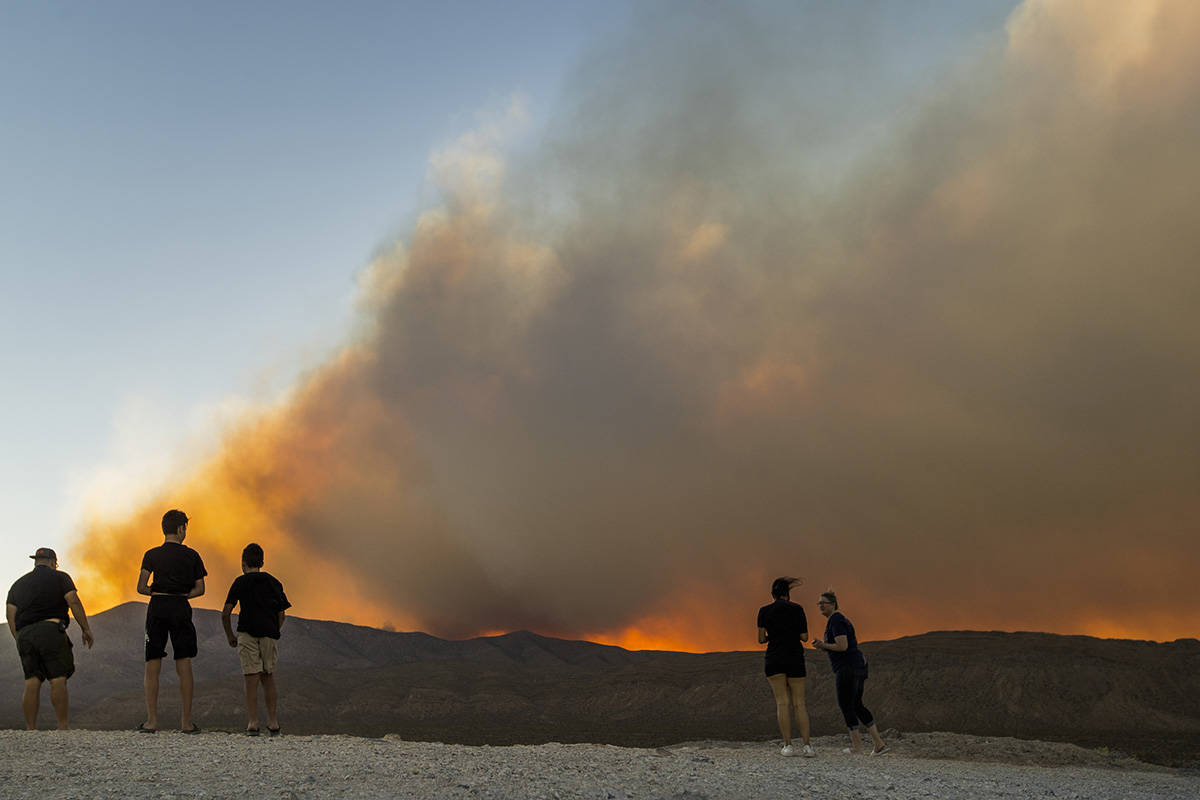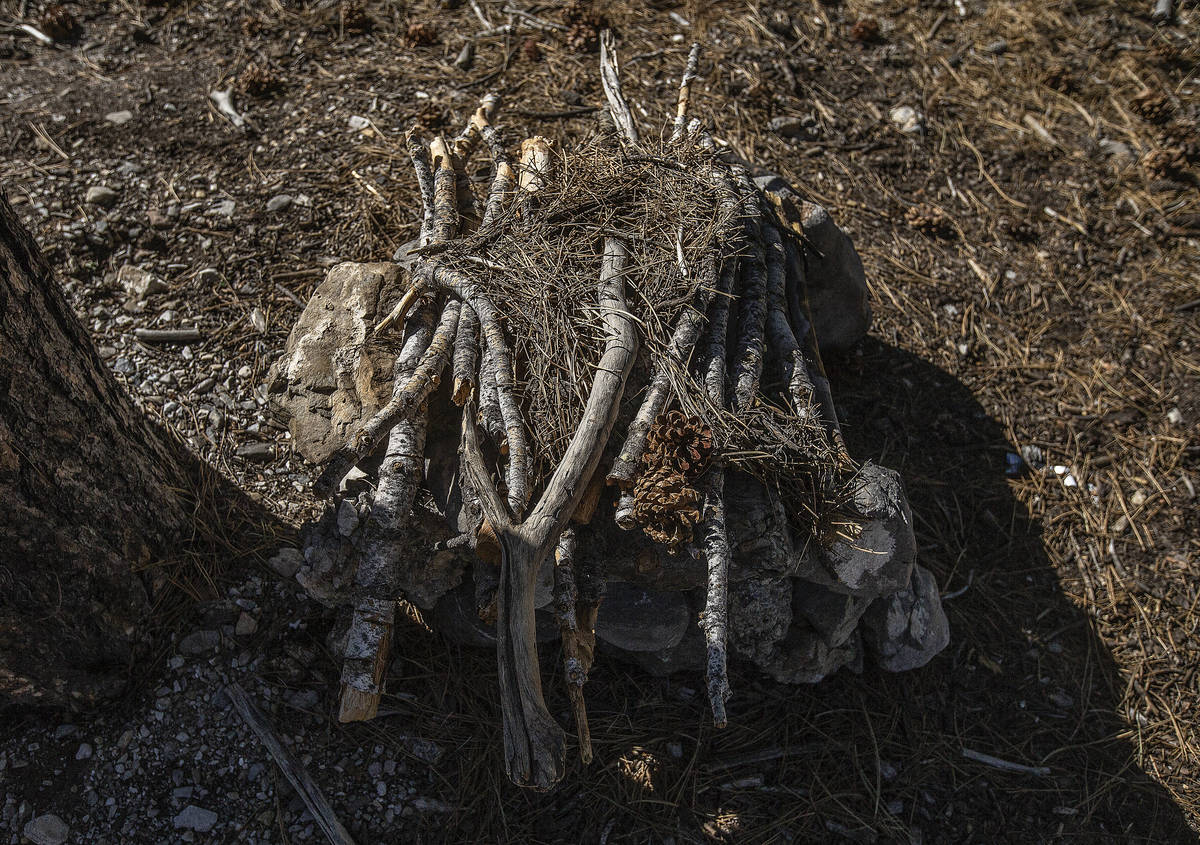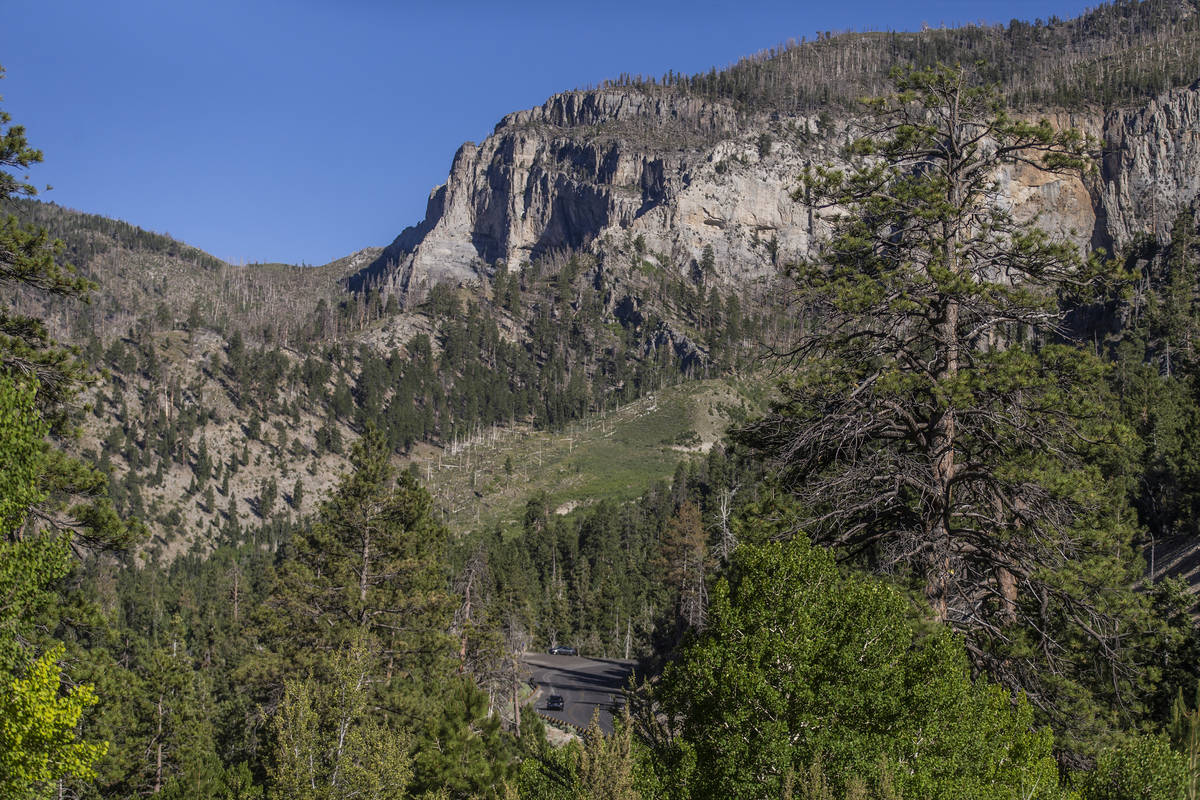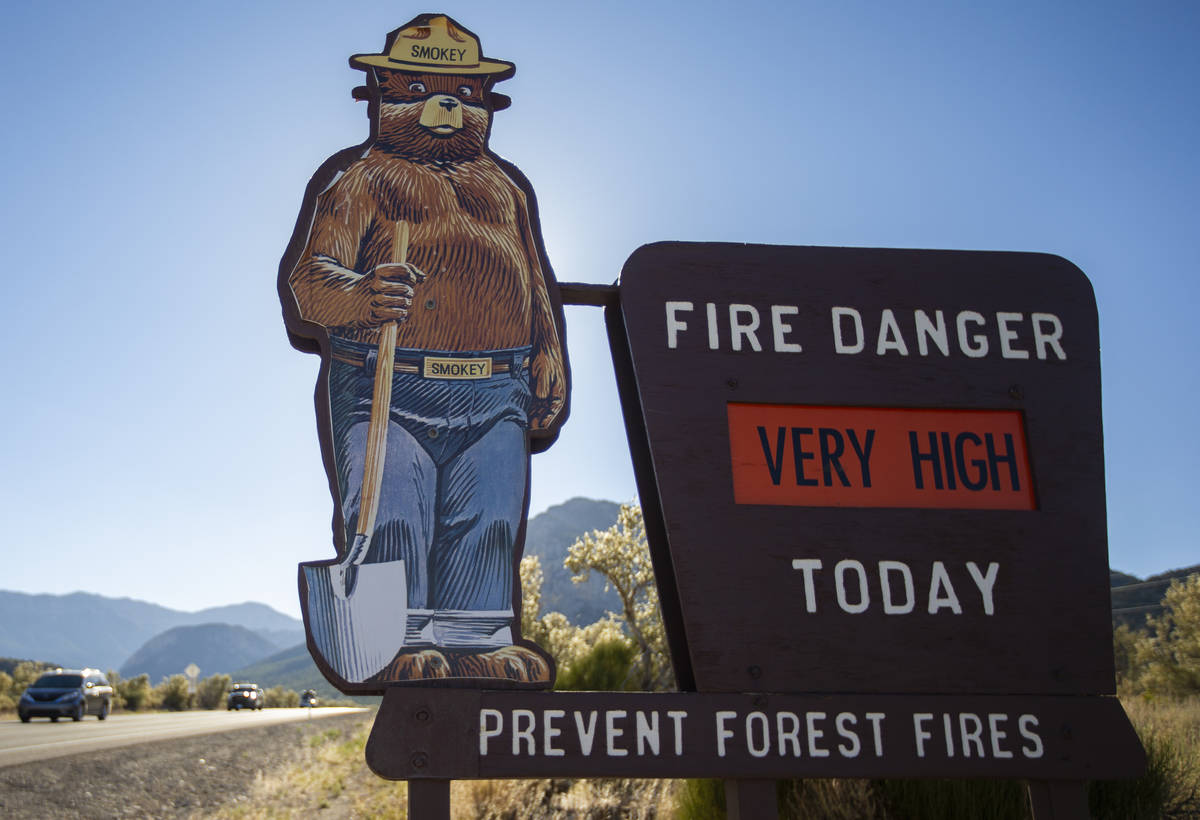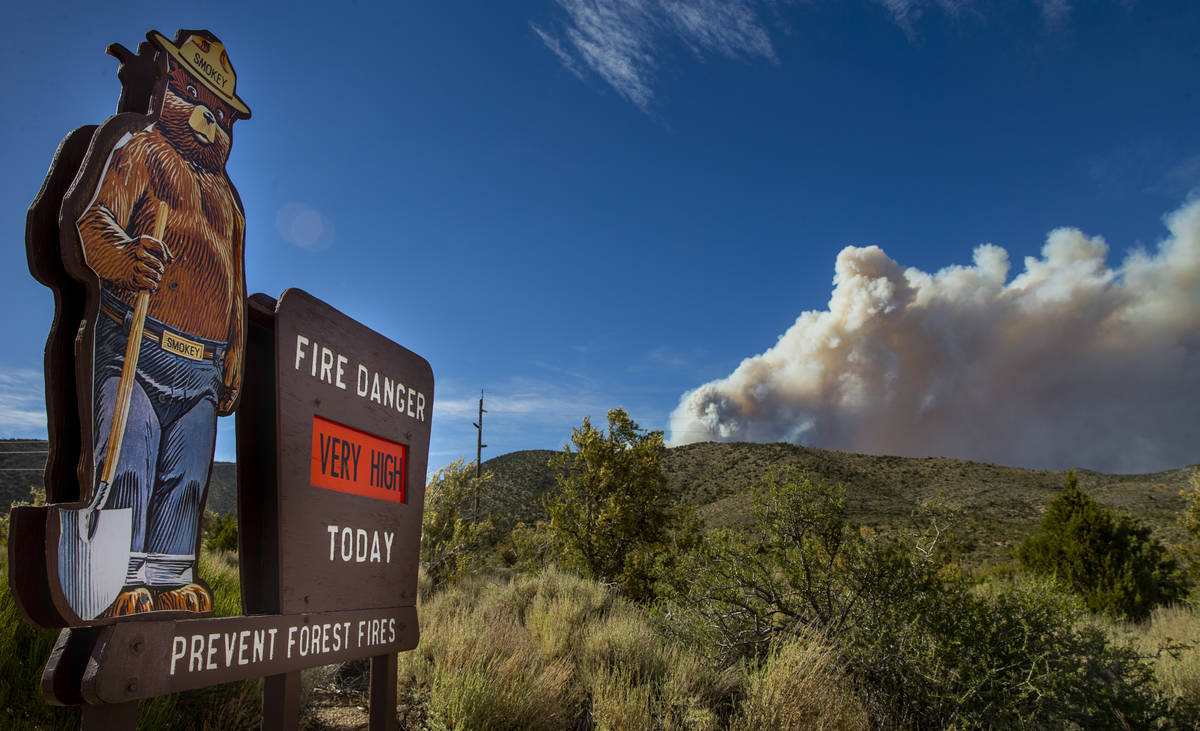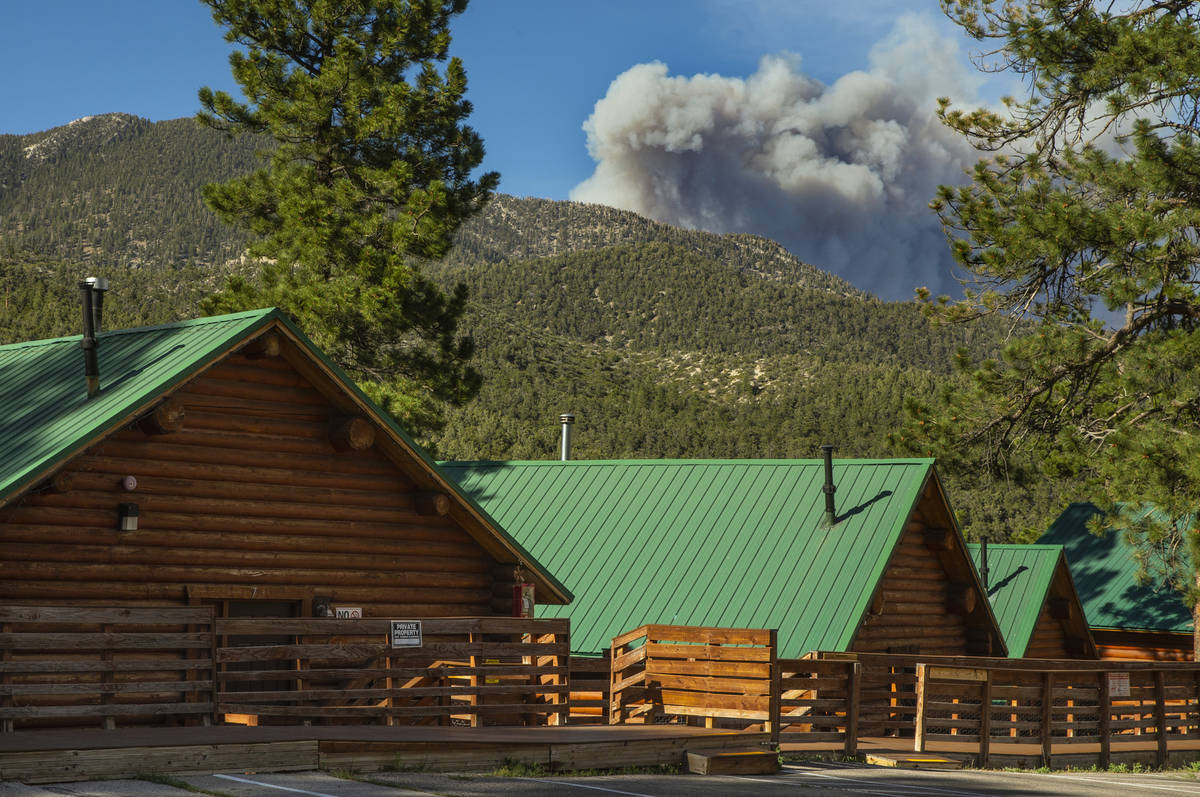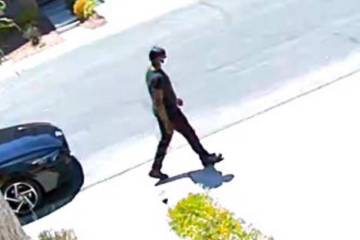Mount Charleston residents seek stricter enforcement of fire safety rules
Long-distance runner Stephanie Ibasco wasn’t surprised to learn the suspected cause of the Mahogany Fire near Mount Charleston is an illegal campfire.
Ibasco, 38, runs the scenic, woodland trails around Mount Charleston daily, making her highly aware of the persistent illegal campfires that appear along the mountain’s trails in the Humboldt-Toiyabe National Forest.
It was only a matter of time, Ibasco said, until one of those campfires would break free.
That time, authorities believe, arrived on the afternoon of June 28, when embers from an illegal campfire near the Mahogany campground apparently blew into nearby brush and trees, igniting what became known as the Mahogany Fire.
The wind-fueled flames of the Mahogany swept through the mountainous region.
“It was frustrating because the week leading up to the fire that started last Sunday, I’d reported seven other fires I’d seen on my runs with zero response,” Ibasco said.
Ibasco and her husband, Mike, 39, are among a group of Mount Charleston-area residents demanding more stringent enforcement of fire safety measures on the mountain by the U.S. Forest Service. More than 20 residents of the area signed a recent letter seeking more enforcement of fire safety rules on the mountain. The letter will be delivered to public policy makers this week.
“Signage, back country permits. All these things we’ve been saying for years and years,” Ibasco said, adding, “If they are understaffed, we will help. We will volunteer and form a committee and do what it takes.”
The U.S. Forest Service, praised for its quick response in putting out the Mahogany Fire and others like it, said it has a massive task in patrolling the forest’s expansive Spring Mountains National Recreation Area.
The recreation area is more than 317,000 acres and hosts approximately 2 million visitors a year, according to Erica Hupp, public affairs staff officer for the Forest Service.
Forest Service law enforcement officers and fire prevention technicians regularly patrol the recreation area, supported by the Mount Charleston Fire Protection District, Metropolitan Police Departmen and Nevada Highway Patrol, Hupp said. “The SMNRA also has staff that have been trained as Forest Protection Officers who are authorized to conduct limited enforcement activities including issuing warning notices and violation notices,” she said. “Due to the size of the SMNRA and our limited staff, we work with numerous partners to get out fire prevention messages to the public.”
More fires, more people
The Mahogany Fire was fully contained on Tuesday after burning 2,758 acres in the Spring Mountain Range. The Forest Service said the suspected cause is an illegal campfire near the Mahogany campground.
“The USDA Forest Service is currently seeking information from the public as to whom may have started the fire,” Hupp said Friday. “If the public has any information about the Mahogany Fire, they need to contact Crime Stoppers at 702-385-5555.”
This fire was tiny compared with the Carpenter 1 fire, which engulfed the area in 2013. Carpenter 1 burned more than 28,000 acres and was believed to have been started by lightning.
Since 2011 there have been 569 lightning-caused fires in the entire forest. In the Spring Mountains recreation area, from 2016 to early July, there have been 48 human-caused fires and 35 fires caused by lightning.
A recent wildfire in Northern Nevada, the Numbers Fire, has burned more than 17,000 acres near Gardnerville. The cause of the fire is under investigation. But several campfire rings were found near the site of a much smaller fire, the Rose Fire, in the Humboldt-Toiyabe National Forest on Slide Mountain this past week, according to the Reno Gazette-Journal.
Overall, the National Park Service says 85 percent of wildland fires in the United States are started by human activity.
Mahogany’s message
Meanwhile, public usage of Mount Charleston has exploded in recent years in concert with relentless population growth in the Las Vegas Valley. Clark County Commissioner Larry Brown, who represents the scattered communities on the flanks of Mount Charleston, said increased usage of the mountain and its surrounding federal lands has spiked, as have frustrations of residents living in Kyle and Lee canyons and on the mountain itself.
“I think first off we are very fortunate,” Brown said. “Fortunate or very lucky that there haven’t been more of these incidents over the last decade. Carpenter 1 was major. This Mahogany is another reminder of how fragile Mount Charleston really is.”
Brown said a configuration of public agencies work in the area on public safety, including the Forest Service, the Bureau of Land Management, Metropolitan police, the Clark County Fire Department and a volunteer force on the mountain. The agency responsible for enforcing bans and rules regarding campfires is the Forest Service, which the county has partnered with to tackle the increased demand on public resources.
“The volume of visitors, the traffic, the illegal parking, trespassing,” Brown said. “I can certainly say over my 12 years the increase of people visiting Mount Charleston — it is no secret anymore — have caused a lot of these social issues.”
Hupp said the Forest Service disseminates a lot of information aimed at preventing fires, including the posting of fire restrictions on roads, kiosks, trails and trailheads. She said fire restrictions are advertised on the Forest Service and Go Mt. Charleston website as well as Facebook and Twitter.
Asked what the penalties are for camping outside of a campground, Hupp said that dispersed camping is generally allowed in the recreation area except in areas specifically closed to camping, such as Lee Meadows and Archery Range.
“An individual can be fined up to $5,000 and/or six months in prison for illegally camping in areas closed to this activity or having a campfire while disperse camping when fire restrictions are in place,” she said. “In addition, anyone found responsible for starting a wildfire can be held civilly and criminally liable.”
Brown said the Forest Service doesn’t have the number of people necessary to patrol the lands around the mountain as is needed.
“They don’t have the resources to truly monitor and have oversight of all the various areas, be it campgrounds, trails, parking areas, to truly cover what the neighbors would love to see,” Brown said. “That is the difficulty they are dealing with day in and day out — an inability to cover everything that needs to be covered. How do you fix that?”
“The biggest challenge with Mount Charleston right now is it is being inundated, and it is a very fragile ecosystem up there that we have to plan for accordingly,” he said. “If that means more resources from an enforcement standpoint, we would be ones to support that.”
U.S. Sen. Catherine Cortez Masto’s office said in a statement that the Nevada senator is aware the Forest Service is facing extensive challenges with limited resources.
“Senator Cortez Masto regularly communicates with the U.S. Forest Service and other governmental agencies that protect our wildlands and she understands the challenges they face when working to protect our public spaces with limited resources,” the statement said. “She’ll continue advocating in Congress to ensure that our dedicated federal employees, firefighters and park rangers have the funding and support they need to carry out their mission and keep Nevadans safe.”
Frustrations rise on the mountain
Mount Charleston resident Misty Haji-Sheikh, 61, is one of the residents frustrated by what she feels is a lack of protection from fire on the mountain. She, like other residents, said that when a fire breaks out and power is cut off, residents of Kyle Canyon lose cellphone service. It is a frightening experience that leaves residents wondering if they should be evacuating or not.
“That happened with the Mahogany Fire,” she said, adding, “The communication is such a problem.”
She is similarly concerned about a lack of enforcement of fire pit rules on federal lands at the mountain. Haji-Sheikh has drafted a lengthy letter to public safety officials including the Forest Service that was signed by 19 of her neighbors.
“I have seen illegal campfires on the trails, including illegally chopped trees – on one recent hike I came across no less than 10 new areas where fires had occurred,” Haji-Sheikh said.
Ibasco said she’s been reporting illegal campsites and fires to the Forest Service for approximately eight years and there is a lack of enforcement of the rules regarding fires. She said she’s regularly told that the Forest Service doesn’t have enough people to do the level of enforcement she is seeking. Still, she said there are solutions within reach.
“I have been over the past eight years handed to probably 10 different people through (the Forest Service),” she said.
Sought-after safety steps
Haji-Sheikh and her neighbors are seeking what they describe as common-sense steps that can help improve public safety on the mountain. They include:
■ The ability to call 911 at all times via cellphone and a siren that alerts residents to danger.
■ Signage along state Routes 156 and 157 warning of no burn bans, no fireworks, and no drones, along details of where fires are allowed and not allowed.
■ A usage fee, or even a parking fee can be instituted even if it is only in place during peak periods.
“Finally, your help is the least costly, most effective way to make the change that is needed for all of us,” Haji-Sheikh wrote in her letter. “If you cannot help directly, let me know who I and my fellow residents can contact (please include their contact information), and please help us lobby Clark County, the State of Nevada and the federal government for new legislation.”
Contact Glenn Puit at gpuit @reviewjournal.com or 702-383-0390. Follow @GlennatRJ on Twitter.



